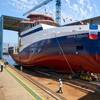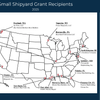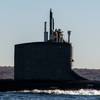Hybrid Propulsion System for LNG Tankers
Siemens is now offering an alternative, whereby the boil-off is also used to generate electrical energy and propel the ship. The main feature of the hybrid solution is its two SGT 500 gas turbines. The turbines are capable of using gaseous and liquid fuels such as heavy oil and marine diesel – simultaneously, and their useful life is around three times longer than other types of turbines. Each turbine has an output of 17,000 kW at 360 rpm. Another 10,000 kW of power is obtained from the waste gases, which are just under 380 °C. This is done by means of two heat-recovery units and one steam turbine. As an option, a diesel generator, which typically provides another 5000 kilowatts, can be integrated in the overall electrical power generation system.
Electrical energy on board is distributed by either 11 kilovolt or 6.6 kilovolt medium-voltage switchgear. In a typical configuration, this set-up supplies two 20,000 kilowatt motors via DC link converters motors, for example, in order to operate the ship's propeller. The redundant design ensures that propulsion power is available even if some subsystems fail. The compressors and pumps in the cargo area and the electrical low-voltage on-board power supply system are linked-up via transformers.










